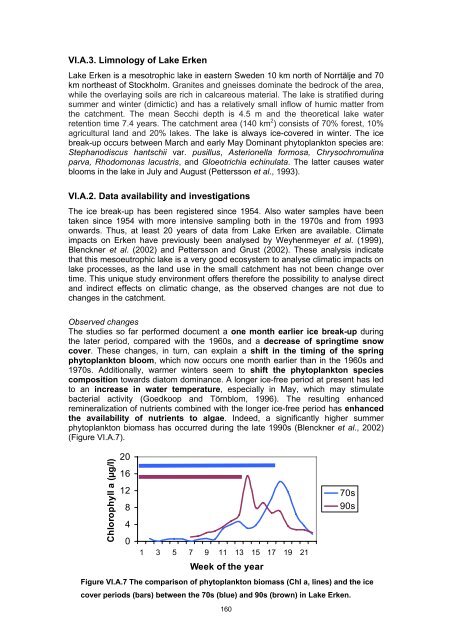Climate Change and the European Water Dimension - Agri ...
Climate Change and the European Water Dimension - Agri ...
Climate Change and the European Water Dimension - Agri ...
Create successful ePaper yourself
Turn your PDF publications into a flip-book with our unique Google optimized e-Paper software.
VI.A.3. Limnology of Lake Erken<br />
Lake Erken is a mesotrophic lake in eastern Sweden 10 km north of Norrtälje <strong>and</strong> 70<br />
km nor<strong>the</strong>ast of Stockholm. Granites <strong>and</strong> gneisses dominate <strong>the</strong> bedrock of <strong>the</strong> area,<br />
while <strong>the</strong> overlaying soils are rich in calcareous material. The lake is stratified during<br />
summer <strong>and</strong> winter (dimictic) <strong>and</strong> has a relatively small inflow of humic matter from<br />
<strong>the</strong> catchment. The mean Secchi depth is 4.5 m <strong>and</strong> <strong>the</strong> <strong>the</strong>oretical lake water<br />
retention time 7.4 years. The catchment area (140 km 2 ) consists of 70% forest, 10%<br />
agricultural l<strong>and</strong> <strong>and</strong> 20% lakes. The lake is always ice-covered in winter. The ice<br />
break-up occurs between March <strong>and</strong> early May Dominant phytoplankton species are:<br />
Stephanodiscus hantschii var. pusillus, Asterionella formosa, Chrysochromulina<br />
parva, Rhodomonas lacustris, <strong>and</strong> Gloeotrichia echinulata. The latter causes water<br />
blooms in <strong>the</strong> lake in July <strong>and</strong> August (Pettersson et al., 1993).<br />
VI.A.2. Data availability <strong>and</strong> investigations<br />
The ice break-up has been registered since 1954. Also water samples have been<br />
taken since 1954 with more intensive sampling both in <strong>the</strong> 1970s <strong>and</strong> from 1993<br />
onwards. Thus, at least 20 years of data from Lake Erken are available. <strong>Climate</strong><br />
impacts on Erken have previously been analysed by Weyhenmeyer et al. (1999),<br />
Blenckner et al. (2002) <strong>and</strong> Pettersson <strong>and</strong> Grust (2002). These analysis indicate<br />
that this mesoeutrophic lake is a very good ecosystem to analyse climatic impacts on<br />
lake processes, as <strong>the</strong> l<strong>and</strong> use in <strong>the</strong> small catchment has not been change over<br />
time. This unique study environment offers <strong>the</strong>refore <strong>the</strong> possibility to analyse direct<br />
<strong>and</strong> indirect effects on climatic change, as <strong>the</strong> observed changes are not due to<br />
changes in <strong>the</strong> catchment.<br />
Observed changes<br />
The studies so far performed document a one month earlier ice break-up during<br />
<strong>the</strong> later period, compared with <strong>the</strong> 1960s, <strong>and</strong> a decrease of springtime snow<br />
cover. These changes, in turn, can explain a shift in <strong>the</strong> timing of <strong>the</strong> spring<br />
phytoplankton bloom, which now occurs one month earlier than in <strong>the</strong> 1960s <strong>and</strong><br />
1970s. Additionally, warmer winters seem to shift <strong>the</strong> phytoplankton species<br />
composition towards diatom dominance. A longer ice-free period at present has led<br />
to an increase in water temperature, especially in May, which may stimulate<br />
bacterial activity (Goedkoop <strong>and</strong> Törnblom, 1996). The resulting enhanced<br />
remineralization of nutrients combined with <strong>the</strong> longer ice-free period has enhanced<br />
<strong>the</strong> availability of nutrients to algae. Indeed, a significantly higher summer<br />
phytoplankton biomass has occurred during <strong>the</strong> late 1990s (Blenckner et al., 2002)<br />
(Figure VI.A.7).<br />
Chlorophyll a (µg/l)<br />
20<br />
16<br />
12<br />
8<br />
4<br />
0<br />
1 3 5 7 9 11 13 15 17 19 21<br />
Week of <strong>the</strong> year<br />
160<br />
70s<br />
90s<br />
Figure VI.A.7 The comparison of phytoplankton biomass (Chl a, lines) <strong>and</strong> <strong>the</strong> ice<br />
cover periods (bars) between <strong>the</strong> 70s (blue) <strong>and</strong> 90s (brown) in Lake Erken.













